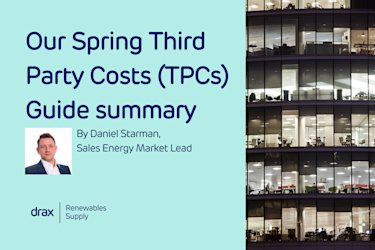Falling demand impacts Third Party Costs
At Drax Energy Solutions, we published our latest Third Party Costs (TPCs) Guide on 25 March exclusively to customers and partners. Today, we examine a snapshot of analysis from within the report: the trend of falling annual electricity demand in Great Britain (GB).

Total calendar year CfD demand continues to decline
Total system annual demand continued to fall in GB during 2023, lowering the number of units over which many costs are spread and thereby increasing the £/unit costs.
To demonstrate this phenomenon, we’ve used Contracts for Difference (CfD) eligible demand in the graph below (which uses data that’s not temperature adjusted). The diagram shows the total demand over which it’s possible to spread the costs of supporting the generation capacity awarded CfD contracts.
Total CfD eligible demand has dropped 10% from 293.5TWh in 2018 to 264.2TWh in 2023. We can see the impacts of Covid in 2020 and the subsequent rebound in 2021. But, this is an average drop of around 6TWh per year.

What’s influencing this demand reduction? A combination of factors:
- Improved energy efficiency of building fabric and appliances
- High energy costs during 2021 and 2022 have incentivised minimising consumption
- Increased behind the meter (BtM) and private wire generation
Let’s look closer at this confluence of high energy costs and increased BtM generation.
Energy prices and BtM solar deployment
The following graph shows day-ahead wholesale power prices (lilac) vs solar installs. The dotted line is all MW per month, and the dashed and solid lines show installations of less than 50kW and 10kW respectively. These thresholds are important because assets under 50kW could potentially be installed on a large business or public building, and assets under 10kW are almost certainly rooftop solar PV.

Between January 2023 and 2024, 965MW of solar PV was installed. 815MW (84%) of this was less than 50kW in capacity, while 67% was less than 10kW and clearly BtM. We can see an uptick in installations as power prices rose to £100/MWh plus, in the period from January 2021 to February 2023. This clearly shows a trend between rising power prices and the number of solar installs. We’ve subsequently seen a small drop in the number of installations as prices have first stabilised and receded, although they remain above background levels.
Other factors have come into play here too, of course, like the falling cost of solar PV panels. Cheap Chinese solar module imports have led to some European retailers pricing PV panels at under 100 Euros per 540w panel. This has led analysts to note that mounting the structures is more expensive than purchasing the panels themselves. This may be a temporary phenomenon, due in part to international politics and production incentives in China, or could be a more enduring trend.
At an 11% load factor, assuming it’s all consumed BtM, 815MW of solar PV would knock ¾ of a TWh off annual demand. We can assume it’s not all going to be consumed on-site, and that this is an under-reporting of the true number of installations. So, this is certainly contributing to the drop in the demand.
Recent and emerging trends
It’s worth noting that, despite these levels of solar installation, eligible CfD demand has only dropped by 5.3TWh compared to over 6TWh in some previous years. As adoption of electric vehicles (EVs) and heat pumps grows, electricity demand is expected to increase. Certainly, three of the four National Grid Future Energy Scenarios 2023 predict an increase in annual electricity demand in 2024. Standards organisation MCS highlighted that 2023 was a record year for heat pumps, with 35,000 certified installations across the UK. Similarly, the UK vehicle licensing statistics published by the Department for Transport revealed that zero emission cars accounted for 16.6% of all new vehicle registrations in Q3 2023. This was up from 14.5% in Q3 2022, and represents an increase each year. Increased electrification of heat and transport is expected to drive electricity consumption upwards.
It remains to be seen whether GB electricity demand grows this year, or whether continued deployment of BtM generation and improved energy efficiency pushes the rise into future years. Certainly, the increased energy intensive industry (EII) levy exemptions under the British Industry Supercharger (BIS) will further restrict the volumes over which policy costs can be recovered in 2024 and beyond.
One thing’s for sure though: a continuing fall in electricity demand will drive up costs on a per unit basis. Every 10% reduction in chargeable demand equates to an 11% increase in cost per unit of energy. Due to the non-linear relationship between costs and demand, a 20% reduction in demand results in a 25% increase in per unit cost.
Drax Energy Solutions publishes regular Intelligence on the energy market for its customers and partners. This includes thought leadership papers, webinars, and insights. To find out more about our Intelligence content, please email daniel.starman@drax.com.
Drax Energy Solutions offers customers renewable electricity as standard and a range of products and services to help decarbonise their business. To discuss the benefits of allowing us to be your net zero partner, get in touch using the button below.
Get in touch


